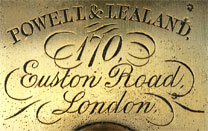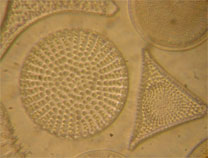 |
|||||
 |
 |
||||
 |
|||||
 |
 |
||||
Powell & Lealand Binocular Model No. 2—Large Compound Microscope (No. 150) |
|||||||||||||
 |
Age: 1861 Made by: Powell & Lealand Made in: England |
||||||||||||
 |
|||||||||||||
|
Powell and Lealand
170 Euston Road, London |
|||||||||||||
 |
|||||||||||||
|
Imaging
|
|||||||||||||
|
This all brass, compound binocular microscope is an example of Powell & Lealand's Model No. 2, showing the tripod supporting the fine-focus limb. The microscope is actually a "convertible" type instrument that could be either monocular or binocular (as displayed here). Although not the earliest binocular microscope, it may be one of the earliest to use a Wenham prism, which was first employed commercially in about 1860 for binocular vision. The microscope comes with five objective lenses with focal lengths ranging from 1 1/2" to 1/8 inch. All lenses are equipped with tibe-length correction collars. Coarse focus is rack and pinion, and moves a triangular support pillar. Fine focus is the Long Arm style that uses a lever to raise of lower the objective mount. The condenser is particulary interesting in that it consists of a main, adjustible frams and several different condenser inserts for imaging using brightfield, darkfield, and polarized light microscopy. The mirror is mounted on an articulated arm, which is itself mounted to the descending support pillar. The stage is mechanical and has both X and Y movement. Imaging is very good showing no chromatic aberration. There are four sets of eyepieces ranging in magnification and use. The microscope is 47.5cm tall. Hugh Powell (1799–1883) and Peter Lealand were brothers-in-law who formed a partnership in London in 1841 that became "one of the most famous associations in the history of the microscope." Powell had begun earlier on his own, producing instruments for the trade and marking them with his own name, Hugh Powell, as early as 1840. By 1843 they had designed a large brass instrument incorporating their tripod suspension and "long-lever" fine focusing device. This remained their basic design for over 60 years. For a more thorough discussion of Powell see here. It is signed Powell & Lealand 1861. There is an engraved dedication on a portion of the movable stage, to Mr. John Harker, with dates of 1855 and 1856. |
|||||||||||||
| The optics of this microscope was studied by students of UC Berkeley.
A comparison of Models No.1, 2 is found here. |
|||||||||||||
| Microscope featured 1/04, 9/14 | |||||||||||||